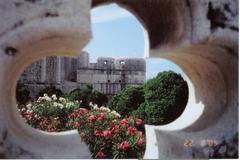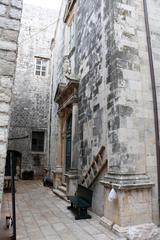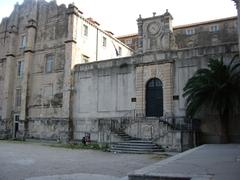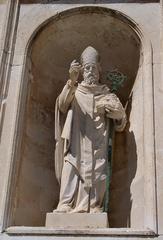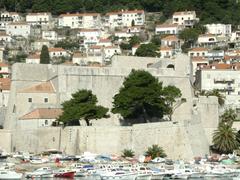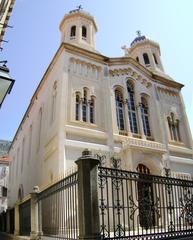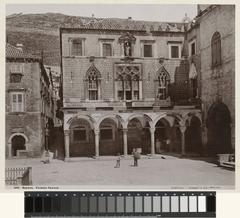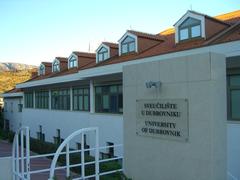St. Blaise Church Dubrovnik: Visiting Hours, Tickets, and Historical Significance
Date: 14/06/2025
Introduction: The Heart of Dubrovnik’s Heritage
St. Blaise Church (Crkva sv. Vlaha), standing gracefully at the eastern end of Dubrovnik’s Stradun, is a testament to the city’s deep religious traditions and resilient spirit. Dedicated to Dubrovnik’s patron saint, Saint Blaise, the church is not only a stunning Baroque architectural gem but also a symbol of centuries-old faith and civic pride. Having survived fires, earthquakes, and wars, St. Blaise Church today remains a place of worship, a cultural landmark, and the epicenter of the city’s most celebrated festivities, including the UNESCO-recognized Feast of Saint Blaise (History Hit; The Dubrovnik Guide; CroatiaWeek).
This guide provides all you need to know for your visit: current opening hours, ticket policies, accessibility, and must-see highlights, plus expert tips for making the most of your time at St. Blaise Church and nearby Dubrovnik historical sites.
Historical Overview
Early Foundations and Medieval Origins
The religious significance of St. Blaise Church predates its current Baroque form. A Romanesque church dedicated to Saint Blaise originally stood on the site, serving as a spiritual and civic anchor for the independent Republic of Ragusa. This earlier structure, with its medieval architecture, was central to Dubrovnik’s religious life (History Hit).
The 1706 Fire and Baroque Rebirth
In 1706, a catastrophic fire destroyed the Romanesque church, sparing only a remarkable 15th-century silver-gilt statue of Saint Blaise—today one of the church’s most treasured artifacts. The Senate of Dubrovnik swiftly commissioned Venetian architect Marino Gropelli to construct a new church, completed in 1715. The choice of a Venetian architect reflected both the influence of Venetian culture and Dubrovnik’s cosmopolitan ambitions (History Hit).
Architectural Splendor
The new Baroque church features a grand staircase, Corinthian columns, and a richly decorated façade illuminated at night, making it a visual landmark in Luža Square (History Hit). Its inscribed Greek cross plan, central dome, and lavish interior—complete with marble altars, gilded ornamentation, and intricate frescoes—reflect the artistic excellence of Venetian Baroque.
Cultural and Religious Significance
Saint Blaise: Protector of Dubrovnik
Saint Blaise (Sveti Vlaho) has been revered in Dubrovnik since the 10th century. According to legend, he appeared in a vision to warn the city of a Venetian attack, leading to his veneration as protector and patron. His image, often depicted holding a model of the city, is found throughout Dubrovnik, symbolizing protection and unity (bodyandsoulinternational.com; Reliquarian).
The Feast of St. Blaise: UNESCO Recognition
The annual Feast of St. Blaise on February 3rd is a vibrant expression of Dubrovnik’s identity, recognized as UNESCO Intangible Cultural Heritage (UNESCO). The feast features processions, masses, the blessing of throats, and traditional music and dance. The church becomes the centerpiece of citywide celebrations, uniting residents and visitors in a blend of faith, culture, and communal pride (CroatiaWeek).
Practical Visitor Information
Location and Setting
St. Blaise Church is located at the eastern end of Stradun, in Luža Square, at the heart of Dubrovnik’s UNESCO-listed Old Town (Collective Travel Guides). It is easily accessible on foot and surrounded by other historical sites such as Sponza Palace, Rector’s Palace, and Dubrovnik Cathedral.
Opening Hours
- Regular Hours: 9:00 AM – 6:00 PM daily (may vary on religious holidays and during special events such as the Feast of St. Blaise).
- Tip: Early morning or late afternoon visits are recommended to avoid crowds.
Tickets and Admission
- Entry: Free of charge. Donations are welcome to support maintenance and preservation.
- Special Events: Some guided tours or exhibitions may require a small fee.
Accessibility
- General: The church is in a pedestrian zone, with a staircase at the main entrance. While the interior is partially accessible, visitors with mobility challenges may require assistance.
- Tip: The surrounding square is fully accessible, allowing all visitors to appreciate the exterior and festivities.
Dress Code and Etiquette
- Modest attire is required: cover shoulders and knees, remove hats inside.
- Photography is permitted inside, but flash is discouraged to protect artworks.
- Observe quiet and respectful behavior, especially during services.
Architectural and Artistic Highlights
Exterior Features
- Façade: Three-part articulation with a round gable and a grand staircase, adorned with statues of St. Blaise, angels, allegorical figures, and Venetian masquerons (Baroque Art Database).
- Night Illumination: The church’s balustrade and stained glass are beautifully lit at night (Kompas.hr).
Interior Masterpieces
- Main Altar: Crafted from white marble, featuring the 15th-century silver-gilt statue of St. Blaise holding a model of Dubrovnik (Croatia Traveller).
- Artworks: Includes a 17th-century quintych, “The Martyrdom of St. Blaise,” by Petar Matejević, and stained glass windows by Ivo Dulčić.
- Preserved Relics: Stone saints by Nikola Lazanić from the earlier church, plus intricate frescoes and ceiling paintings (History Tools).
Restoration
The church has undergone several restorations, most recently after damage in the 1990s Croatian War of Independence. Restoration efforts preserved its artistic and architectural legacy (Kompas.hr).
Special Events and Festivities
- Feast of St. Blaise (February 3rd): The highlight of Dubrovnik’s cultural calendar, featuring processions, Mass, and the blessing of throats (UNESCO).
- Other Events: The church hosts regular religious services, weddings, and baptisms, remaining a living center of community life.
Nearby Attractions
Combine your visit to St. Blaise Church with these nearby Dubrovnik historical sites:
- Sponza Palace: Renaissance architecture and city archives.
- Rector’s Palace: Museum and former seat of the Republic of Ragusa.
- Dubrovnik Cathedral: Home to relics and priceless artworks.
- Stradun: The city’s vibrant main street.
- City Walls: Panoramic views and history (Collective Travel Guides).
Frequently Asked Questions (FAQ)
What are the church’s opening hours?
Regularly 9:00 AM–6:00 PM; check local information for updates during holidays.
Is there a fee to enter?
No; entrance is free, though donations are appreciated.
Are guided tours available?
Yes, many walking tours of Dubrovnik Old Town include the church.
Is the church accessible for visitors with disabilities?
Partial accessibility; the main entrance has stairs. The square outside is fully accessible.
Can I take photos inside?
Yes, without flash.
When is the Feast of St. Blaise?
Annually on February 3rd, featuring processions and celebrations.
Tips for a Memorable Visit
- Visit during the Feast of St. Blaise for an unforgettable cultural experience.
- Join a walking tour for expert insights into the church’s history and art.
- Take time with the details: Admire the façade, the altar, and the statue’s miniature city.
- Respect the sacred atmosphere and local customs.
- Enjoy the illuminated exterior in the evening for stunning photographs.
Plan Your Visit and Next Steps
St. Blaise Church is not just a tourist attraction; it is the living heart of Dubrovnik’s heritage. Whether you’re drawn by its architecture, its art, or its role in the city’s traditions, a visit here offers a profound connection to Dubrovnik’s past and present.
Plan your visit today and explore more Dubrovnik historical sites with our expert guides. Download the Audiala app for up-to-date visiting hours, audio tours, and exclusive cultural insights. Follow us on social media for festival updates and travel inspiration.
Sources and Further Reading
This guide draws on the following resources for accurate and detailed information:
- Church of Saint Blaise Dubrovnik: Visiting Hours, Tickets, and Historical Guide, 2025, History Hit
- Visiting St. Blaise Church in Dubrovnik: History, Tickets, and Cultural Significance, 2025, The Dubrovnik Guide
- Dubrovnik’s Big Day To Be Celebrated Again In San Pedro, CroatiaWeek
- Festivity of St. Blaise, UNESCO Intangible Cultural Heritage
- Visiting St. Blaise Church Dubrovnik: Hours, Tickets, and Architectural Highlights, Croatia Traveller & Kompas.hr
- Baroque Art Database
- Collective Travel Guides
- Reliquarian
- Kompas.hr
- History Tools

